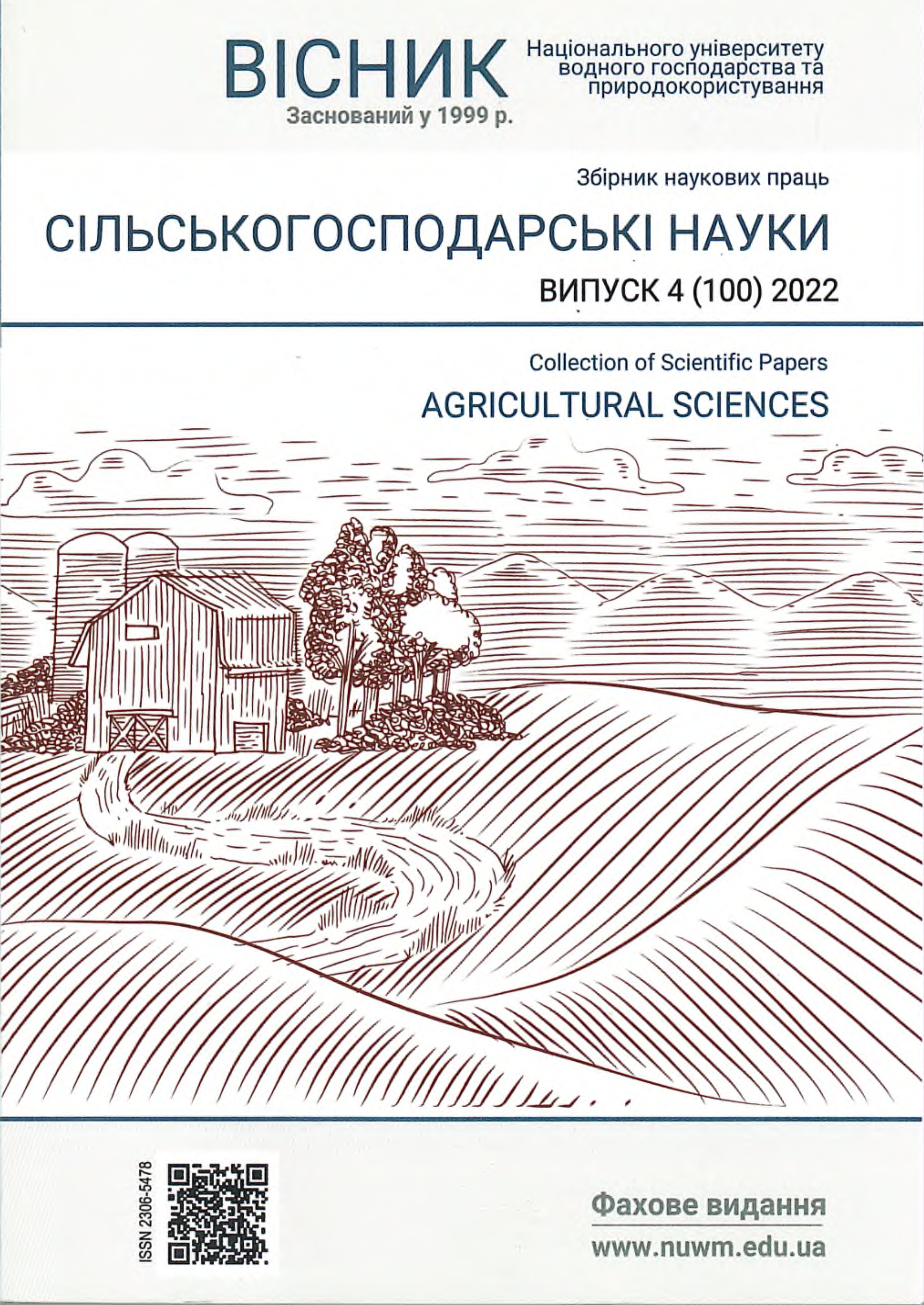BIOINDICATION OF THE STATE OF ATMOSPHERIC AIR USING THE PINE PINUS SYLVESTRIS L. UNDER THE INFLUENCE OF POULTRY FARMS
Keywords:
Scots pine, needle, sanitary protection zone, bioindication, lateral necrosis, apical necrosis.Abstract
The article presents the results of studies of the impact of emissions from poultry farms on the condition of Scots pine (Pinus sylvestris L.). The obtained data showed that in the territory of the sanitary protection zone of the poultry farm, the percentage of conifers with spots and signs of drying was 35%, while in the control area it was 5% in 2020 and 30% and 0% in 2021, respectively.According to research data, there is a decrease in the absolute values of the length of Scots pine needles in plantations with the approach to the poultry farm and with an increase in the level of environmental pollution. There is also an increase in the number of needles on the shoot, which also indicates air pollution around the poultry farm.The lower value of the absolute dry weight of conifers (9.48) in the territory of the SРZ of the poultry farm also indicates the negative impact of the activity of the poultry enterprise on Scots pine plants, since the value of this indicator was 18.32 in the territory of the control plot. The state of the environment was determined based on the complex of morphological features (needles) of Scots pine (Pinus sylvestris L.) in the production area of poultry enterprises. It was established that the length of the needles of Scots pine (Pinus sylvestris L.) decreases with the approach to the SРZ of the poultry farm due to the increase in the level of air pollution by toxicants. It has been proven that the use of coniferous woody plants is informative when conducting bioindication of contaminated territories in the area of production activities of farms for the production of livestock products.In individuals of Scots pine under conditions of pollution, there is a change in morphometric indicators, in particular, the degree of necrotic damage and its nature, length, width, their weight, as well as the number per 10 cm of a shoot.It is established that the level of toxicity of the air category of environmental safety sanitary protection zone of the poultry farm belongs to the class of "dangerous" with a high level usage note and critical as bio-indicators.The state of the environment, for complex morphological traits (needles) for Scots pine Pinus sylvestris L. in the area of production activities of poultry enterprises. Found that the length of the needles of Scots pine Pinus sylvestris L. is reduced with the approach to the sanitary protection zone of the poultry farm due to increasing air pollution by toxicants. It is proved that the use of coniferous woody plants is informative when conducting bioindication of polluted territories in the area of production activities of households for livestock production.References
Андреев А. В. Оценка биоразнообразия, мониторинг и екосети. Кишинев : BIOTICA, 2002. 168 с.
Аргунова Е. В. Научные основы мониторинга ресурсов агросферы АР Крым для повышения эффективности сельскохозяйственного производства с учётом региональных особенностей. Вісник аграрної науки. 2011. № 3. С. 16–18.
Бессонова В. П., Фендюк Л. М., Пересипкіна Т. М. Можливості використання декоративних квіткових рослин для фітоіндикації забруднення навколишнього середовища. Український Ботанічний Журнал. 1996. № 3. Т. 53. С. 224–229.
Біоіндикація і біологічний моніторинг. URL: http://ecodelo.org/9557-412_bioindikatsiya-4_bioindikatsiya_i_biologicheskii_monitoring. (дата звернення: 10.06.2022).
Дідух Я. П. Основи біоіндикації : монографія. К. : Наукова думка, 2012. 344 с.
Екологічна безпека Вінниччини : монографія / за заг. ред. Олександра Мудрака. Вінниця : ВАТ «Міська друкарня», 2008. 456 с. 7. Ярошенко Ф. О. Птахівництво України: стан, проблеми і перспективи розвитку. К. : Аграрна наука, 2004. 506 с.
Eremektar G., Ubay Çokgör E., Övez S., Germirli Babuna F., Orhon D. Biological treatability of poultry processing plant effluent. Water Science and Technology. 1999. Vol. 40. № 1. P. 323–329.
Gill C. O., Moza L. F., Badoni M., Barbuthttp S. The effects on the microbiological condition of product of carcass dressing, cooling, and portioning processes at a poultry packing plant. International Journal of Food Microbiology. 2006. Vol. 110. № 2. P. 187–193.
REFERENCES:
Andreev A. V. Otsenka bioraznoobraziya, monitoring i ekoseti. Kishinev : BIOTICA, 2002. 168 s.
Argunova E. V. Nauchnyie osnovyi monitoringa resursov agrosferyi AR Kryim dlya povyisheniya effektivnosti selskohozyaystvennogo proizvodstva s uchёtom regionalnyih osobennostey. Visnyk ahrarnoi nauky. 2011. № 3. S. 16–18.
Bessonova V. P., Fendiuk L. M., Peresypkina T. M. Mozhlyvosti vykorystannia dekoratyvnykh kvitkovykh roslyn dlia fitoindykatsii zabrudnennia navkolyshnoho seredovyshcha. Ukrainskyi Botanichnyi Zhurnal. 1996. № 3. T. 53. S. 224–229.
Bioindykatsiia i biolohichnyi monitorynh. URL: http://ecodelo.org/9557-412_bioindikatsiya-4_bioindikatsiya_i_biologicheskii_monitoring. (data zvernennia: 10.06.2022).
Didukh Ya. P. Osnovy bioindykatsii : monohrafiia. K. : Naukova dumka, 2012. 344 s.
Ekolohichna bezpeka Vinnychchyny : monohrafiia / za zah. red. Oleksandra Mudraka. Vinnytsia : VAT «Miska drukarnia», 2008. 456 s.
Yaroshenko F. O. Ptakhivnytstvo Ukrainy: stan, problemy i perspektyvy rozvytku. K. : Ahrarna nauka, 2004. 506 s.
Eremektar G., Ubay Çokgör E., Övez S., Germirli Babuna F., Orhon D. Biological treatability of poultry processing plant effluent. Water Science and Technology. 1999. Vol. 40. № 1.
P. 323–329.
Gill C. O., Moza L. F., Badoni M., Barbuthttp S. The effects on the microbiological condition of product of carcass dressing, cooling, and portioning processes at a poultry packing plant. International Journal of Food Microbiology. 2006. Vol. 110. № 2. P. 187–193.

